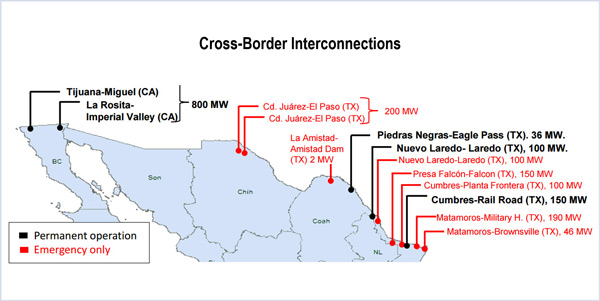FERC last week granted AEP Energy Partners’ request to transmit power between ERCOT and Mexico over existing DC tie connections, easing concerns that the Texas grid operator might find itself subject to the federal agency’s jurisdiction (TX18-1).
The American Electric Power subsidiary made the request on behalf of Sharyland Utilities, AEP Texas and Electric Transmission Texas. The DC tie operators asked the commission to allow them to provide transmission service over the ties and to confirm that the ties’ use would not subject ERCOT or any of its market participants to FERC jurisdiction.
Texas officials have expressed unease that a pair of transmission projects along the U.S.-Mexico border could place ERCOT’s freedom from federal jurisdiction in jeopardy.
The ISO’s transmission grid is located solely within the state and not synchronously interconnected with the rest of the U.S. Under the Federal Power Act, FERC has no jurisdiction over transmission lines that cross international boundaries if they don’t also cross U.S. state lines. ERCOT has several synchronous (AC) and asynchronous (DC) ties with Mexico, but energy does not flow between Texas and other states through Mexico’s national grid.
Public Utility Commission Chair DeAnn Walker has said the federal agency could exert its jurisdiction over ERCOT through the U.S. Constitution’s Commerce Clause “if the commingling of power between ERCOT and the rest of the United States occurs.” (See Regulators Fear Cross-Border Tx Risks ERCOT’s FERC Exemption.)
Sharyland sister company Nogales Transmission has applied for a presidential permit to build an HVDC interconnection between Arizona and Mexico (OE PP-420). Nogales last year asked the Department of Energy to delay processing its permit until it can obtain “the necessary FERC disclaimer” of jurisdiction.
Further west, Mexico is considering a major project that would link the state of Baja California, which is part of the Western Electricity Coordinating Council, with the rest of the country’s grid and with California.
ERCOT said it was pleased with the FERC order. “[It] alleviates any current or future jurisdictional concerns resulting from new interconnection projects with Mexico and other neighboring states,” spokesperson Leslie Sopko told RTO Insider.
AEP asserted that if FERC granted the parties’ request, the DC ties would become facilities for the transmission and wholesale sales of electric energy in interstate commerce “solely by reason of” a commission order.
“The continuing operation of the ties in compliance with the requested Section 211 order would not cause the tie operators to become ‘public utilities’” as defined by the FPA, the utilities said.
Commission Eases 2006 Requirements on Westar Energy
The commission on July 27 granted Westar Energy’s request to remove mitigation measures and reporting requirements imposed in connection with its 2006 acquisition of a ONEOK Energy Services gas plant (EC06-48).
Westar asked FERC to remove the measures and quarterly and annual reporting requirements, saying that changes in the SPP market since the 2006 acquisition made the decade-old requirements no longer necessary. SPP went live in 2014 with its Integrated Marketplace, which included day-ahead, real-time and financial transmission rights markets, and a consolidated balancing authority that replaced 16 legacy BAs.
In approving Westar’s acquisition of ONEOK’s 300-MW Spring Creek facility and a 75-MW power purchase agreement from the Oklahoma Municipal Power Authority (OMPA), the commission ordered the utility to increase transfer capabilities into its BA to reduce its 42% share of the market.
Westar requested a clarification of the order, committing to not use 225 MW of network integration transmission service during the winter period. The commission granted the request, but OMPA in 2007 requested a rehearing. FERC asserted Westar had asked SPP to move Spring Creek from the Oklahoma Gas & Electric BA to Westar’s, undermining the mitigation alternative. FERC agreed, directing that Westar continue to model the facility in OG&E’s BA.
Westar filed its request in 2016, arguing that SPP’s consolidated BA meant its market share should be measured using the RTO’s entire capacity, rather than that of the utility’s former BA area. It also pointed out that the OMPA contract had expired in 2015.
SWEPCO ROE with East Texas Co-ops Reduced
FERC on July 26 approved a settlement agreement between Southwestern Electric Power Co. and two East Texas cooperatives, East Texas Electric (ETEC) and Northeast Texas Electric (ER18-1560).
The settlement reduces SWEPCO’s return on equity with ETEC from 11.1% to 10.1%, effective Sept. 1, 2017. It also revises the utility’s formula rate templates that govern its power supply agreements with the two co-ops.
— Tom Kleckner





